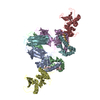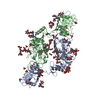[English] 日本語
 Yorodumi
Yorodumi- PDB-4c3g: cryo-EM structure of activated and oligomeric restriction endonuc... -
+ Open data
Open data
- Basic information
Basic information
| Entry | Database: PDB / ID: 4c3g | ||||||
|---|---|---|---|---|---|---|---|
| Title | cryo-EM structure of activated and oligomeric restriction endonuclease SgrAI | ||||||
 Components Components |
| ||||||
 Keywords Keywords |  HYDROLASE / HYDROLASE /  RESTRICTION ENDONUCLEASE / RESTRICTION ENDONUCLEASE /  ALLOSTERY / DNA CLEAVAGE / PARASITE-HOST INTERACTION ALLOSTERY / DNA CLEAVAGE / PARASITE-HOST INTERACTION | ||||||
| Function / homology |  Restriction endonuclease, type II, Cfr10I/Bse634I / Cfr10I/Bse634I restriction endonuclease / Restriction endonuclease type II-like / identical protein binding / Restriction endonuclease, type II, Cfr10I/Bse634I / Cfr10I/Bse634I restriction endonuclease / Restriction endonuclease type II-like / identical protein binding /  metal ion binding / metal ion binding /  DNA / DNA (> 10) / SgraIR restriction enzyme DNA / DNA (> 10) / SgraIR restriction enzyme Function and homology information Function and homology information | ||||||
| Biological species |   STREPTOMYCES GRISEUS (bacteria) STREPTOMYCES GRISEUS (bacteria) | ||||||
| Method |  ELECTRON MICROSCOPY / ELECTRON MICROSCOPY /  single particle reconstruction / single particle reconstruction /  cryo EM / Resolution: 8.6 Å cryo EM / Resolution: 8.6 Å | ||||||
| Model type details | CA ATOMS ONLY, CHAIN A, B | ||||||
 Authors Authors | Lyumkis, D. / Talley, H. / Stewart, A. / Shah, S. / Park, C.K. / Tama, F. / Potter, C.S. / Carragher, B. / Horton, N.C. | ||||||
 Citation Citation |  Journal: Structure / Year: 2013 Journal: Structure / Year: 2013Title: Allosteric regulation of DNA cleavage and sequence-specificity through run-on oligomerization. Authors: Dmitry Lyumkis / Heather Talley / Andrew Stewart / Santosh Shah / Chad K Park / Florence Tama / Clinton S Potter / Bridget Carragher / Nancy C Horton /  Abstract: SgrAI is a sequence specific DNA endonuclease that functions through an unusual enzymatic mechanism that is allosterically activated 200- to 500-fold by effector DNA, with a concomitant expansion of ...SgrAI is a sequence specific DNA endonuclease that functions through an unusual enzymatic mechanism that is allosterically activated 200- to 500-fold by effector DNA, with a concomitant expansion of its DNA sequence specificity. Using single-particle transmission electron microscopy to reconstruct distinct populations of SgrAI oligomers, we show that in the presence of allosteric, activating DNA, the enzyme forms regular, repeating helical structures characterized by the addition of DNA-binding dimeric SgrAI subunits in a run-on manner. We also present the structure of oligomeric SgrAI at 8.6 Å resolution, demonstrating the conformational state of SgrAI in its activated form. Activated and oligomeric SgrAI displays key protein-protein interactions near the helix axis between its N termini, as well as allosteric protein-DNA interactions that are required for enzymatic activation. The hybrid approach reveals an unusual mechanism of enzyme activation that explains SgrAI's oligomerization and allosteric behavior. | ||||||
| History |
|
- Structure visualization
Structure visualization
| Movie |
 Movie viewer Movie viewer |
|---|---|
| Structure viewer | Molecule:  Molmil Molmil Jmol/JSmol Jmol/JSmol |
- Downloads & links
Downloads & links
- Download
Download
| PDBx/mmCIF format |  4c3g.cif.gz 4c3g.cif.gz | 54.8 KB | Display |  PDBx/mmCIF format PDBx/mmCIF format |
|---|---|---|---|---|
| PDB format |  pdb4c3g.ent.gz pdb4c3g.ent.gz | 35.7 KB | Display |  PDB format PDB format |
| PDBx/mmJSON format |  4c3g.json.gz 4c3g.json.gz | Tree view |  PDBx/mmJSON format PDBx/mmJSON format | |
| Others |  Other downloads Other downloads |
-Validation report
| Arichive directory |  https://data.pdbj.org/pub/pdb/validation_reports/c3/4c3g https://data.pdbj.org/pub/pdb/validation_reports/c3/4c3g ftp://data.pdbj.org/pub/pdb/validation_reports/c3/4c3g ftp://data.pdbj.org/pub/pdb/validation_reports/c3/4c3g | HTTPS FTP |
|---|
-Related structure data
| Related structure data |  2441MC M: map data used to model this data C: citing same article ( |
|---|---|
| Similar structure data |
- Links
Links
- Assembly
Assembly
| Deposited unit | 
|
|---|---|
| 1 |
|
- Components
Components
| #1: Protein | Mass: 37884.855 Da / Num. of mol.: 2 / Fragment: DNA-BINDING DOMAIN, RESIDUES 2-338 Source method: isolated from a genetically manipulated source Details: AN SGRAI DIMER. THE OLIGOMERIC HELIX IS FORMED FROM MULTIPLE COPIES OF SUCH SGRAI DIMERS BOUND TO DNA. Source: (gene. exp.)   STREPTOMYCES GRISEUS (bacteria) / Plasmid: PET21A_SGRA1R / Production host: STREPTOMYCES GRISEUS (bacteria) / Plasmid: PET21A_SGRA1R / Production host:   ESCHERICHIA COLI (E. coli) / Strain (production host): ER2566 / References: UniProt: Q9F6L0 ESCHERICHIA COLI (E. coli) / Strain (production host): ER2566 / References: UniProt: Q9F6L0#2: DNA chain | Mass: 5547.588 Da / Num. of mol.: 2 / Source method: obtained synthetically Details: 2 COPIES OF PRE-CLEAVED DNA CONTAINING STICKY ENDS AND THE SGRAI RECOGNITION SEQUENCE Source: (synth.)   STREPTOMYCES GRISEUS (bacteria) STREPTOMYCES GRISEUS (bacteria)#3: DNA chain | Mass: 6722.343 Da / Num. of mol.: 2 / Source method: obtained synthetically Details: 2 COPIES OF PRE-CLEAVED DNA CONTAINING STICKY ENDS AND THE SGRAI RECOGNITION SEQUENCE Source: (synth.)   STREPTOMYCES GRISEUS (bacteria) STREPTOMYCES GRISEUS (bacteria) |
|---|
-Experimental details
-Experiment
| Experiment | Method:  ELECTRON MICROSCOPY ELECTRON MICROSCOPY |
|---|---|
| EM experiment | Aggregation state: HELICAL ARRAY / 3D reconstruction method:  single particle reconstruction single particle reconstruction |
- Sample preparation
Sample preparation
| Component | Name: HELICAL ASYMMETRIC UNIT OF AN SGRAI DNA-BOUND DIMER / Type: COMPLEX |
|---|---|
| Buffer solution | Name: 10 MM TRIS-HCL PH 8.0, 150 MM NACL, 5 MM CA(OAC) 2, 0.5 MM DTT pH: 8 Details: 10 MM TRIS-HCL PH 8.0, 150 MM NACL, 5 MM CA(OAC) 2, 0.5 MM DTT |
| Specimen | Conc.: 0.2 mg/ml / Embedding applied: NO / Shadowing applied: NO / Staining applied : NO / Vitrification applied : NO / Vitrification applied : YES : YES |
| Specimen support | Details: HOLEY CARBON |
Vitrification | Instrument: HOMEMADE PLUNGER / Cryogen name: ETHANE Details: SPECIMENS WERE PREPARED FOR CRYO-EM BY APPLYING 3 MICROLITERS OF SAMPLE IN BINDING BUFFER TO A HOLEY CARBON C-FLAT GRID (CF-2- 2-400) (PROTOCHIPS, INC.) THAT HAD BEEN PLASMA CLEANED (GATAN, ...Details: SPECIMENS WERE PREPARED FOR CRYO-EM BY APPLYING 3 MICROLITERS OF SAMPLE IN BINDING BUFFER TO A HOLEY CARBON C-FLAT GRID (CF-2- 2-400) (PROTOCHIPS, INC.) THAT HAD BEEN PLASMA CLEANED (GATAN, SOLARUS) FOR 5 SEC. THE SAMPLE WAS ALLOWED TO ADSORB TO THE GRID FOR 30 SEC., THEN PLUNGE-FROZEN INTO LIQUID ETHANE USING A MANUAL CRYO-PLUNGER AT 4 C. |
- Electron microscopy imaging
Electron microscopy imaging
| Experimental equipment |  Model: Tecnai F20 / Image courtesy: FEI Company |
|---|---|
| Microscopy | Model: FEI TECNAI F20 / Date: Sep 19, 2012 |
| Electron gun | Electron source : :  FIELD EMISSION GUN / Accelerating voltage: 200 kV / Illumination mode: FLOOD BEAM FIELD EMISSION GUN / Accelerating voltage: 200 kV / Illumination mode: FLOOD BEAM |
| Electron lens | Mode: BRIGHT FIELD Bright-field microscopy / Nominal magnification: 60000 X / Calibrated magnification: 41000 X / Nominal defocus max: 3000 nm / Nominal defocus min: 1000 nm / Cs Bright-field microscopy / Nominal magnification: 60000 X / Calibrated magnification: 41000 X / Nominal defocus max: 3000 nm / Nominal defocus min: 1000 nm / Cs : 2 mm : 2 mm |
| Image recording | Electron dose: 16 e/Å2 / Film or detector model: DIRECT ELECTRON DE-12 (4k x 3k) |
| Image scans | Num. digital images: 656 |
| Radiation wavelength | Relative weight: 1 |
- Processing
Processing
| EM software |
| ||||||||||||
|---|---|---|---|---|---|---|---|---|---|---|---|---|---|
CTF correction | Details: INDIVIDUAL PARTICLES | ||||||||||||
3D reconstruction | Method: PROJECTION-MATCHING / Resolution: 8.6 Å / Num. of particles: 1918 / Nominal pixel size: 1.42 Å / Actual pixel size: 1.42 Å / Magnification calibration: CATALASE CRYSTALS Details: WE FIRST CONDUCTED 25 ITERATIONS OF THE IHRSR ROUTINE TO REFINE THE FULL CRYODATA SET AND OBTAIN FINAL HELICAL PARAMETERS -- -86.2 HELICAL TWIST AND 21.6 A RISE. SUBSEQUENTLY, THE MODEL FROM ...Details: WE FIRST CONDUCTED 25 ITERATIONS OF THE IHRSR ROUTINE TO REFINE THE FULL CRYODATA SET AND OBTAIN FINAL HELICAL PARAMETERS -- -86.2 HELICAL TWIST AND 21.6 A RISE. SUBSEQUENTLY, THE MODEL FROM IHRSR WAS USED FOR REFINEMENT IN FREALIGN SPECIFYING DIFFERENT DOSE- -FRACTIONATED STACKS FOR THE REFINEMENT (32 E- PER A2) AND RECONSTRUCTION (16 E- PER A2) ROUTINES. THE FINAL RECONSTRUCTION WAS OBTAINED FROM 1,918 FILAMENT SEGMENTS, AVERAGED 8 TIMES TO ACCOUNT FOR THE HELICAL SYMMETRY BASES WERE OMITTED FROM THE FITTED DNA. ONLY THE PHOSPHATE-SUGAR BACKBONE IS SHOWN. SUBMISSION BASED ON EXPERIMENTAL DATA FROM EMDB EMD-2441. (DEPOSITION ID: 11901). Symmetry type: HELICAL | ||||||||||||
| Atomic model building | Protocol: FLEXIBLE FIT / Space: REAL / Details: METHOD--DIREX REFINEMENT PROTOCOL--FLEXIBLE | ||||||||||||
| Atomic model building | PDB-ID: 3DVO | ||||||||||||
| Refinement | Highest resolution: 8.6 Å | ||||||||||||
| Refinement step | Cycle: LAST / Highest resolution: 8.6 Å
|
 Movie
Movie Controller
Controller







 PDBj
PDBj







































